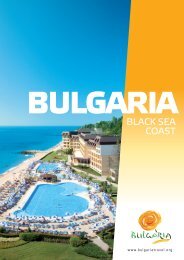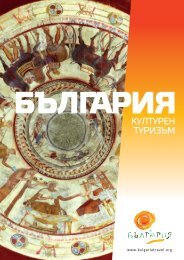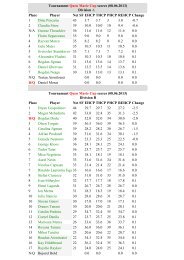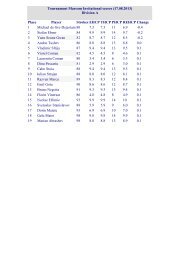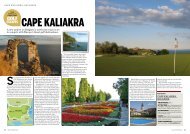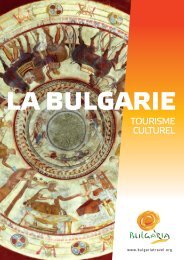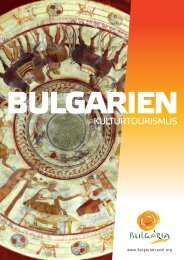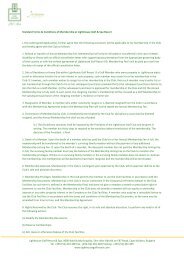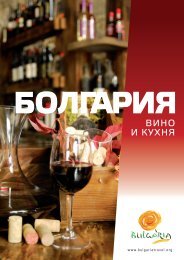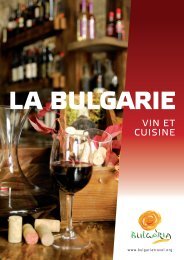WINE AND CUISINE
WINE AND CUISINE
WINE AND CUISINE
- No tags were found...
You also want an ePaper? Increase the reach of your titles
YUMPU automatically turns print PDFs into web optimized ePapers that Google loves.
Unique factsabout BulgariaHistory of wine inthe Bulgarian landsWine production has over a thousand year longtradition in Bulgaria. The ancient Thracians, whopopulated the land in ancient times, worshippedthe gods Zagreus and Dionysius and used the wineduring their religious rituals. Nowadays Bulgaria is aproud producer of fine quality wines, some of whichare made from unique sorts of vine, impressing wineconnoisseurs worldwide.Wine is an integral part of the history of Bulgaria, it is also very mucha part of Bulgarian culture, customs and spirit. The Bulgarian landsare rooted in ancient civilizations which have left an indelible imprinton modern Bulgaria. The ancient Thracians used wine as an importantpart of their religious rituals and as a mean of communing with theirgods. Evidence for this can be found in the many shrines discoveredthroughout the country, which bring to mind the ancient rituals andthe cult of the god of wine, Zagreus. Bulgaria is home to some of themost important archaeological discoveries, including gold and silverThracian pieces, most of which were parts of beautiful sets used forserving and consuming wine.The use of the Orphic drink in religious rituals is associated withtraditions in viticulture and winemaking. Homer often mentions in hisworks the superior quality of Thracian wines.The traditional Bulgarian cuisine is rich inspices, with specific and unique taste. MostBulgarian meals are easy to prepare – ifyou follow a traditional recipe to preparean authentic Bulgarian meal, you will feelthe Bulgarian spirit and cosy atmosphere.The spices, fruit and vegetables used are organic.Only in Bulgaria one can experience the taste of theworld-famous Bulgarian yoghurt, as well as delicacyprepared with it. Bulgaria produces the rich flavouredwhite cheese and rich tasting herbal honey.With the establishment of the Bulgarian Statethese wine-making traditions were absorbedand preserved. Many medieval travellers whopassed through Bulgaria referred to the manydifferent types of good quality wines theywere offered. In the late 19th and early 20thcentury a professional approach to viticultureand winemaking began to emerge and thefoundations of the modern production methodswere established for Bulgarian wines. Today,high-quality wines from Bulgaria can besampled around the globe. Many of the localwines win international awards and astoundforeign oenophiles with their high quality andexquisite taste.The love of good wine and the interest in localvarieties has brought about an increase ofwine tourism in Bulgaria - wine tours and winetastings. Many of the wineries in the countryorganize special events to introduce theirnewest and best products.1
GamzaGamza is a local red variety, which thrives bestin North-western Bulgaria - Suhindol, Vidin andPleven. The grapes of this variety mature lateand produce red dessert and table wines. Thesehave a clear bright raspberry colour and a fruity,prevailingly raspberry aroma. They are fresh,light-bodied and should not be flavoured withoak. Gamza wines are usually consumed young.The variety is grown in Macedonia, Romaniaand Hungary, under different names. The bestqualityGamza wines can be found in NorthernBulgaria, in wineries in the region of Vidin andPleven in Northern Bulgaria.UNIQUELOCAL VARIETIESCherven Misket is an old Bulgarian variety, mostly cultivated in theSub-Balkan region. It is the Bulgarian grape variety that is mosthighly resistant to cold. Wine made from it has an interesting pinktint. It is known that the variety is a hybrid created from Rieslingand Dimyat. Its aroma is a bouquet of herbal nuances, quince andhoney. Cherven Misket wine can be sampled in wineries in theregions of Straldzha and Sungurlare.Cherven MisketShiroka MelnishkaShiroka Melnishka is a local redvariety which grows only in theregions of Melnik, Petrich andSandanski, since it is vulnerable tolow temperatures. The colouringof the wine is medium deep. Thewine produced from this grapevariety is of excellent quality, withripe cherry and herbal aromas, andin the presence of oak it developsundertones of tobacco and leather.The flavour of the young wine isfresh, with pronounced tannins.With maturity its taste becomessofter but retains its spicy finish.The unique flavour of the wine fromgrape variety Shiroka Melnishka canbe experienced in the wineries in theregion of Sandanski and Melnik.RubinRubin is a local varietycreated by crossfertilization from twovarieties - Nebbioloand Sora. Its wineshave a deep colourand a full-bodiedflavour with a softaftertaste. Its aromais intense, fruity, witha predominance of ripeblackberry. In contactwith oak it develops ahint of fruit jam. Rubinwines can be tasted atwineries in the region ofPlovdiv and Septemvri.DimyatDimyat is a typical Bulgarianwhite grape used forproduction of dry white winesas well as aromatic winesand brandies. It develops afruity aroma with hints ofripe peach. Its flavour is mildwith a pleasant freshness. Itgrows best in the region ofVarna but is also grown inother parts of the country.You can sample it in thewineries in the region ofEvksinograd Varna, Shumenand Stara Zagora.MavrudPamid is one of the oldest varietiesgrown in Bulgaria. It is widely foundthroughout the Balkan Peninsulaunder different names. It is suitablefor wine production and freshconsumption. Wine produced fromPamid has a light red colour. Itsaromas are fresh, with fruity notes,elegant body and soft finish. It isconsumed young due to the lowcontent of phenolics and does notrespond well in contact with oak.It is often used in blends. Pamidcan be sampled at wineries in theregion of Pazardzhik, Pamidovoand Plovdiv.PamidMavrud is a very old local variety grown mainly in theareas of Asenovgrad, Plovdiv, Pazardzhik and thefoothills of the Rodopi Mountains. Wine produced fromMavrud is a saturated ruby purple and has an excellentflavour. It has a pronounced rich texture and a lusciousaroma with strong overtones of ripe berry and spices.It ages very well in contact with oak. Several wineries inthe region of Asenovgrad, Plovdiv and Pazardzhik offertasting of Mavrud.4 5
Ingredients: 500 g tomatoes, two cucumbers,1 pepper, 1 onion, 200 g white cheese, parsley (totaste), vinegar, salt and oil (to taste)Dice the tomatoes into cubes. Slice the cucumbersinto rings and finely chop the onion or cut it intocrescents. Slice the pepper into thin strips, add thespices and stir. Crush or grate the cheese on top ofthe seasoned vegetables. Chop parsley finely andsprinkle. It is best to serve the salad well chilled.Olives may be added if desired.(Cheese Pastry)Ingredients: To make the pastry from scratch: 2Shopska SaladBULGARIAN <strong>CUISINE</strong>Banitsacups milk, 1 tsp sugar, 1 tbsp salt, 2 eggs, flour –as much as can be absorbed, 50 g yeastOr: 1 package ready pastry sheets, 400 g whitecheese, 2 eggs, 400 g yoghurt, butterTo prepare the pastry dough mix the milk, salt,sugar, eggs, yeast and flour and allow dough torise. Then tear small balls from the dough androll out on a floured surface.Place the rolled-out sheet on aluminium foil orwrapping foil. Spread a mixture of the eggsand cheese on each sheet. Use the foil to rollup the sheet. The rolled-up sheets are placedon a baking pan in the form of a spiral. Bakein preheated oven at 200-250 °C until brown.HotchpotchIngredients: 500 g pork, 500 gpotatoes, 200 g green beans, 200 geggplant, 100 g okra, 100 g peas, 1onion, 2 carrots, 1-2 tomatoes (freshor canned), parsley, savory, salt,pepper (to taste)Dice the meat into cubes and sautéor stew briefly and put in a crock pot.Cut the vegetables into cubes and addto the hotchpotch. Add the spices andstir. Bake with the lid on for about anhour and a half to two hours in hotoven. The lid may be taken off in thelast 20 minutes to get a crust. In someregions of the country a cup of rice isadded to the dish.FlatbreadIngredients: 1 kg flour, ½ litre of water(or 400 g of yoghurt) , 3 eggs, 1 tsp sugar,1 tbsp salt, vegetable oil, yeast, butterDissolve the yeast in water and add 2eggs stirring constantly. While stirring,add the flour until a homogeneous doughball is formed. Add 1-2 tablespoons ofvegetable oil and leave for 30 minutesto rise, pat into a flat, round shape. Bitsof the dough can be used to decorate thesurface of the loaf. Use one egg to glazethe surface. Separate the yolk from thewhite of the egg and spread the yolk evenlywith a cooking brush. The flatbread is bakedin a preheated oven. It takes about an hourat 200-250 °C.Tarator(Cold Cucumber Soup)Ingredients: 2 cucumbers, 400 g yoghurt,crushed walnuts (to taste), 1 clove of garlic,vegetable oil, dillPeel cucumbers and cut into small cubes.Stir yoghurt while still in the pot. Add to thecucumbers and continue stirring. Add ½ litreof cold water. More or less water may beneeded depending on the desired density.Use a pestle and mortar to crush the cloveof garlic with some salt and add to the soupwith the ground walnuts and finely choppeddill. Season with a little vegetable oil.Tarator is served cold as an appetizer.Ingredients: (For a 3-litre jar), 2 ½to 3 kg vegetables: bell peppers,cauliflower, carrots, cabbage, 500g sugar, 100 g salt, 1 head celery,garlic, 250 ml vinegar, 1 litre ofwater, aspirin, black pepper, bay leafClean the vegetables and cut intocubes. Pack vegetables in a jar astightly as possible. Bring to boilthe water, sugar, salt, vinegar andaspirin (finely ground). Add thespices after removing the marinadefrom the stove. Pour over thevegetables and seal while still hot.Arrange the jars and turn over everyfew days. After two weeks thepickles are ready for consumption.Royal Pickle12 13
Bean SoupIngredients: 250 - 300 g white or pinto beans, 1 carrot, 1onion, 1 dried red pepper, 2 tomatoes (fresh or canned),savory, spearmint and salt to taste, sliced sausage may beadded to the soup, if desired.Soak the beans in water for at least 5-6 hours. Wash them,put them in a pot of water and bring it to a boil. Pour offthe water. Rinse the beans again and add fresh water. If apressure cooker is used it takes 50 minutes to 1 hour. If anordinary pot is used, cook them for a minimum of 2/2 anda half hours.In a separate pan sauté the finely chopped onions, tomatoesand carrots and add them to the beans. Reduce heat tosimmer until all vegetables are soft. Before removing thepot from the stove add the spices.Ingredients: 1 kg pork, 2 tomatoes, 2onions, 2 peppers, thyme, salt, blackpepper, vegetable oilDice the meat, remove the fat andseason with thyme, salt and pepper.Oregano and red wine can also beadded. Soak the meat in the marinadefor several hours.Cut the tomatoes and onions intorings and the peppers into strips.Thread the meat and vegetableson skewers and barbeque. Turn theskewers to cook the meat evenly onall sides.Bulgarian barbequeSkewersCabbage Sarmi(Stuffed Cabbage Leaves)Ingredients: 20 cabbage /sauerkraut/ leaves,2-3 onions, 500 g minced meat, 1 cup rice,paprika, black pepper, savory, parsley, vegetableoil.Fry the finely chopped onions and add the mincedmeat and some water. When the meat is almostdone add the rice and a cup of water. Stir until therice absorbs the water. Add the spices to taste.Cut the solid part of each cabbage leaf. Put a littleof the stuffing in the centre and wrap the sarma.Arrange the ready sarmi in a saucepan and add oneto two cups of water, cover with a few cabbageleaves and simmer.The sarmi may be prepared without meat. If notusing meat, add raisins and walnuts to the ricestuffing.Kebapche(Minced Meat Sausage)Ingredients: 1 kgminced meat (beef ormixed beef/pork), salt(to taste), pepper (totaste), 1 tsp cuminMix the minced meatwith the spices andlet stand to absorbthe flavour. Shape assausages and grill, turnperiodically to cookevenly.Stuffed PeppersIngredients: 8 peppers, 1 onion, 1 cup rice, 1 carrot, ½ kgminced meat, salt, paprika, black pepper, flour.Cut the onions and carrots into small pieces, fry them in oil andadd water to cover. Add minced meat and continue to fry untilthe meat changes colour and is broken down into small pieces.Then add the rice, half a cup of water and seasoning. Stir untilthe rice absorbs the water.Clean the peppers and remove the stems and seeds. Stuffeach pepper with the prepared mixture. Cover the hole andarrange the peppers in baking dish. Add several cups of water.Place pan in a preheated oven.Serve with yoghurt or sauce. For the sauce use an egg, cupyoghurt, two cups of water and 2-3 tablespoons of flour. Mixthese ingredients and let them sit for 5 minutes. Pour overthe peppers just before serving.Ingredients: 1 kg minced meat, 1onion , 1 egg, 1 slice bread, choppedparsley, black pepper, savory, salt,cuminSoak the bread in water or milk,crumple it and add to the mincedmeat. Add the finely chopped orpressed onions, the egg and spices.Knead the minced meat untilwell mixed. Shape balls from themixture. Flatten the balls slightly tomake a patty. Grill on a pre-heatedbarbeque, turn periodically.Meatballs14 15
THE TYPICAL BULGARIAN FOODSHoneyBulgarian honey is very highquality honey, and its taste andnutritional values are impressive.The country produces many kindsof honey and bee products - acacia,herbal, pine, honeydew and polyfloralhoney. The different regionsof the country produce differentkinds of bee products dependingon their natural resources. Someherbs are found only in Bulgariaand there are also some rare orendangered plants here. Thismakes Bulgarian honey deliciousand very unique. It also increasesits healing qualities.Bulgaria produces very high qualitypropolis with proven healingpowers. Propolis has antibacterialand anti-inflammatory propertiesand also stimulates the immunesystem. The propolis produced inthe region of the Rodopes is of thehighest quality.YoghurtYoghurt is a traditional Bulgarianproduct. The microorganism responsiblefor the fermentation of the milk bearsthe name “Lactobacillus bulgaricus” .This dairy product has a very pleasanttaste and is used in the recipes formany beloved Bulgarian dishes: tarator,banitsa, snezhanka salad and as toppingfor some main dishes as well as a soupthickener. In addition to its excellenttaste, it is also beneficial to good health.Studies have shown that it has anticancereffect.According to some legends, yoghurt hasbeen around since Thracian times. TheThracians learned to add sour sheep’smilk to fresh milk in order to make itkeep longer. Therefore a product named“prokish” or leavened milk was created.Other theories associate yoghurt with theBulgars and the drink “kumis”, a drink madefrom horse milk.16 17
CALENDAROF EVENTSA Motley CulinaryFestival to Visit my TownThis culinary festival travels around the country in a effortto collect authentic recipes and to acquaint visitors with thediversity and wealth of Bulgarian cuisine. Chef contests andculinary demonstrations are held.Where: in Bulgaria. When: A Motley Culinary Festival to Visitmy Town is most frequently held during the official holidaysof the individual towns. For more information visit: http://culinaryfestival-bg.comIn Kyustendil some of the mostdelicious Bulgarian cherries are grown.The celebration of this deliciousfruit is held annually in Kyustendil.At the cherry exhibition visitors areencouraged to try different varietiesof cherries. They can also learn moreabout dishes with cherries - jams,compotes and pastries.Where: KyustendilWhen: JuneFestival of the CherryFestival of the BanitsaIn the village of Banitsa in theregion of Vratsa the Banitsa hasbeen celebrated for many years.Naturally, one event is TheMost Delicious Banitsa contest.Visitors to this festival can tastea variety of different Banitsa andenjoy folklore song and dances.Where: Banitsa villageWhen: In MayFestival of the Rila Zelnik(Banitsa with Cabbage)An annual celebration of thezelnik is held in the village ofBeli Iskar in the Samokov region.Local culinary masters competeto produce the most deliciouszelnik. Guests can enjoy thisinteresting type of banitsa aswell as other dishes unique tothe region of Samokov.Where: Beli IskarWhen: JuneThis annual festival introduces visitorsto the town of Gorna Oryahovitsato the sudzhuk - dry spicy sausage.It is produced in this town and hasvarious culinary applications. At theexhibition visitors can try differentkinds of sujuk and learn more abouthow it is prepared.Festival of the SudzhukTo try different varieties of apricotsand foods prepared with them be sureto visit Tutrakan. There an annualcelebration of the apricot is held,where in addition to tasting differentvarieties of apricots, one can samplethe famous Bulgarian apricot rakiya,the Bulgarian brandy.Festival of the ApricotWhere: Gorna OryahovitsaWhere: TutrakanWhen: Late MayWhen: JulyFestival of the YoghurtIn the town of Tran one canlearn more about yoghurt byvisiting the Yoghurt Museumlocated near (7 km) Tran, inthe village of Studen Izvor.There is also an annual yoghurtcelebration. Guests can samplegenuine homemade yoghurt anddairy products.Where: TranSea of WineThe coastal town of Pomorieholds an annual celebration andexhibition dedicated to wine.During the event there is winetasting and awards are given tothe winning wine producer.Where: PomorieWhen: AugustWhen: June18 19
International Honey FestivalEach year the town of Nessebar hoststhe International Honey Festival. It notonly allows guests to learn more abouthoney and other bee products, but alsoincludes workshops where honey producersexchange knowledge.Where: NessebarWhen: Late AugustFestival of the PotatoThe town of Klisurahouses the onlyPotato Museum inthe country. For thisreason the Festivalof the Potato is heldthere. During theevent a visitor cantry many potatodishes and enjoyan exciting folkloreprogram.Where: KlisuraWhen: OctoberIt is not difficult to guess thatthe Festival of the Beansis organized in the Rodopivillage of Smilyan. Here avisitor can taste variousdishes that have beans asan ingredient and can alsobuy Smilyan beans and enjoyan exciting entertainmentprogram.Where: Smilyan.When: NovemberFestival of the Pumpkin20Festival of the Plumand the Troyan Plum RakiaIn the village ofOreshak and the townof Troyan traditionalcelebrations dedicatedto this Bulgarianalcoholic drink areheld every year. Folkmusic performancesare augmented by abest home-made rakia(Bulgarian brandy)contest.Where: TroyanWhen: Last weekendof SeptemberFestival of the BeansPumpkin is widely used inBulgarian cuisine. It is used toprepared tikvenik (pumpkinpastry), jams, creams anddesserts. In Sevlievo one canexplore these culinary delightsduring the annual Festival of thePumpkin. Of course, there is alsoa largest pumpkin contest.Where: SevlievoWhen: NovemberTourist InformationNATIONAL TOURIST INFORMATION CENTRE,MINISTRY OF ECONOMY, ENERGY <strong>AND</strong> TOURISMSOFIA 1040, 1 Sv. Nedelja Sq.Теl.: +359 2 9335826; +359 2 9335821; +359 2 9335811E-mail: e-docs@mee.government.bgSOFIA, subway next to Sofia University „St. Kliment Ohridski“Теl.: +359 2 491 83 44; +359 2 491 83 45E-mail: tourist@info-sofia.bgTROYAN 5600, 133 Vassil Levski Str.Теl.: +359 670/ 6 09 64E-mail: infotroyan@yahoo.com; troyantour@abv.bgSMOLYAN 4700, 5 Bulgaria Blvd.Теl.: +359 30162530; E-mail: toursmolyan@abv.bgTRYAVNA 5350, 33 Angel Kanchev Str.Теl.: +359 677 2247; E-mail: tourinfo-tryavna@globcom.netBANSKO, 1 Nikola Vaptsarov Sq.Теl.: +359 749 885-80; +359 749 88633E-mail: infocenter@bansko.bgPOMORIE 8200, 15 Solna Str.Теl.: +359 596 25236; E-mail: mayor@pomoret.bgRUSE 7000, 61 Aleksandrovska Str.Теl.: +359 82 82-47-04 ; E-mail: tic@tic.rousse.bgSHIROKA LAKA 4710, obl. SmoljanТеl.: +359 3030 2222; E-mail: pesponedelnik@abv.bgЕLENA 5070, 13 Ilarion Makariopolski Str.Теl.: +359 6151 7430; E-mail: otic@elena.bgRAZGRAD 7200, 2 Nezavisimost Sq.Теl.: +359 84 662324; E-mail: ticrazgrad@abv.bgS<strong>AND</strong>ANSKI, 1 Bulgaria Sq.Теl.: +359 746 30549; E-mail: tour_centre@abv.bgGORNA ORJAHOVITSA 5100, 5 G. Izmirliev Sq.Теl.: +359 618 20506; E-mail: tic_go_2004@yahoo.comPLOVDIV, 1 Tsentralen Sq.Теl.: +359 32 656794; +359 32 620229E-mail: tic_plovdiv@abv.bg ; tic.plovdiv@gmail.comSMILYAN 4770 obsht. Smoljan;Chitalishte „Prof. Assen Zlatarov“Теl.: +359 3026 2300; E-mail: smilyan_tourism@abv.bgVARNA 9000, Sv. Sv. Kiril i Metodij Sq.Теl: +359 52 608918; +359 52 608919E-mail: invarna@abv.bgSLIVEN, 1 Tsar Osvoboditel Blvd.Теl.: +359 44 611148; E-mail: infotourist@sliven.bgGENERAL INFO ABOUT BULGARIAMINISTRY OF ECONOMY, ENERGY <strong>AND</strong> TOURISMBulgaria, Sofia 1000, 8 Slavjanska Str.Tel.: +359 2 9407001Fax: +359 2 987 2190; + 359 2 981 9970; + 359 2 981 5039e-mail: e-docs@mee.government.bgwww.mee.government.bgOperational Programme Regional Development 2007-2013www.bgregio.euInvesting in your future!The project is funded by the European Regional Development Fundand the state budget of the Republic of BulgariaGeographic location: Republic of Bulgaria is aEuropean country, located in the Eastern part of theBalkan peninsular. Its Eastern boundary is the BackSea; Greece and Turkey are situated southbound, itsWestern neighbours are The Republic of Macedoniaand Serbia, and to the North it shares border withThe Republic of Romania.Climate: Bulgaria has a mixed Mild-Continentaland Mediterranean influenced climate.Average winter temperatures: 0 °С to -2 °СAverage summer temperatures: 20-22 °СTerritory: 110,099 sq. km.Population: 7 928 901Official language: BulgarianCapital: SofiaCurrency: Bulgarian Lev (1 € = 1.955 BGN)Single European emergency call number: 112Average height above sea level: 470 mHighest point: Musala peak (2925 m.)Time zone: GMT+2 (EST+7)Main denomination: East-orthodox ChristianityOPRDGrant Scheme BG161PO001/3.3-01/2008 „Support for effective national marketing of the tourist product and improvementof the information service”, BG161PO001/3.3-01/2008/001-4 „Design and distribution of advertising materials for promotionof Bulgaria as a tourist destination”This document is created within the framework of the project “Preparation and Distribution of Advertising and Information Materials Promoting Bulgaria as a Tourist Destination”, Contract No BG161PO001/3.3-01/2008/001-4,which is performed with the financial support of Operative Program “Regional Development” 2007 – 2013, co-financed by the European Union through the European Regional Development Fund. The entire responsibilityfor the contents of the document is brought by the beneficiary – The Ministry of Economy, Energy and Tourism, and under no circumstances it can be considered that this document presents the official position of theEuropean Union and the Managing Body.
OPPORTUNITIES THROUGHOUT THE WHOLE YEARBULGARIANBLACK SEACOASTWINTERTOURISMECO TOURS <strong>AND</strong>VILLAGE LIFE<strong>WINE</strong> <strong>AND</strong><strong>CUISINE</strong>




